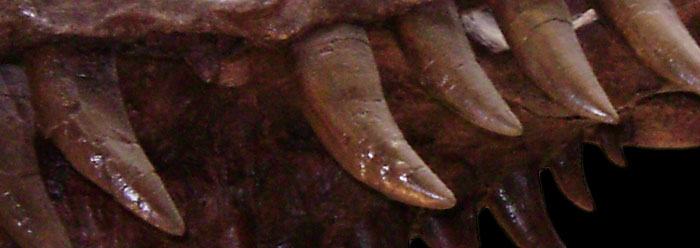A set of fossilized Tyrannosaurus rex teeth was found in a rock layer that it had no business being in, according to evolutionary interpretations. Discovered in Hyogo, Japan, the teeth came from a 15-foot-tall dinosaur entombed in early Cretaceous rock, supposedly deposited 140 million years ago.
The problem is that T. rex dinosaurs of this large size are not supposed to have evolved until about 30 million years later. Thus, what is “known” about dinosaurs must undergo drastic revision.1
Haruo Saegusa, a curator at the Museum of Nature and Human Activities, recently told JapanToday, ‘‘If the dinosaur belongs to the same era of the strata [early Cretaceous], the tyrannosaurus could have started to grow larger much earlier than previously thought.’’2 The thought seems to be that merely adjusting evolutionary development backward will be enough to make the fossil fit the strata.
But the very concept of strata representing “eras” does not come from the strata themselves. That concept began with eighteenth-century French naturalist Georges Cuvier, and it has been in vogue ever since, despite the fact that it causes more problems for interpreting rock strata than it solves, and stands in stark contrast to scriptural history. Young-earth creation geologists have long held that most sedimentary strata—including the Cretaceous layer in which these teeth were found—resulted from waterborne deposits during Noah’s Flood that may harbor fossils from a particular local environment, but do not represent a particular “era.”
The assignment of a certain number of “millions of years” to a rock formation does not derive from the strata either. It is another assumption that is used to prescribe what constitutes “valid” interpretations.
Radioisotope dating is used to bolster the vast time spans ascribed to the geologic record. However, geologist John Woodmorappe cogently revealed that the radio dates are actually hand-picked to coincide with the dates already assigned from the geologic column diagram. ICR’s RATE research also conclusively demonstrated with independent lines of evidence that radioactive decay rates, widely used to bolster deep time, were dramatically accelerated in the past.4
Many other natural processes—like the recession rate of the moon, the decay of earth’s magnetic field, or the diffusion of helium from zircon crystals in granite—can be used, along with some basic assumptions, to measure the age of the earth, but these methods give maximum dates that are incompatible with evolutionary time spans.
Thus, the nineteenth-century strata/age/era correlation is in serious trouble. However, an oversized T. rex found in the “wrong age” and the “wrong time” doesn’t surprise creation scientists. If the rock that these T. rex fossil teeth was found in was indeed deposited during the year-long Noahic Flood, then it is easy to explain why a large dinosaur is found mixed in with smaller ones.
There never was an “era of smaller T-rex dinosaurs,” but there was an unimaginably massive Flood that wiped out whole environments, layering and sorting sediments and fossilizing the creatures buried therein. http://www.icr.org/article/t-rex-teeth-take-bite-out-evolution/
References
- For recent examples of drastic evolutionary revisions, see Sherwin, F. The Devastating Issue of Dinosaur Tissue. ICR News. Posted on icr.org June 1, 2005, accessed June 25, 2009; Thomas, B. Data Derails Dinosaur Dominance Idea. ICR News. Posted on icr.org September 18, 2008, accessed June 25, 2009; Thomas, B. Dinosaur Fossil Erases 40 Million Years. ICR News. Posted on icr.org June 23, 2008, accessed June 25, 2009.
- Teeth of tyrannosaurus ancestor dating back 140 mil years found in Hyogo. JapanToday. Posted on japantoday.com June 20, 2009, accessed June 24, 2009.
- Woodmorappe, J. 1999. The Mythology of Modern Dating Methods. El Cajon, CA: Institute for Creation Research, 27-49.
- Radioisotopes and the Age of the Earth (RATE). Posted on icr.org.
* Mr. Thomas is Science Writer at the Institute for Creation Research.
